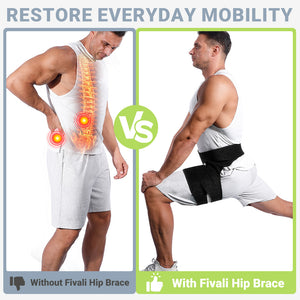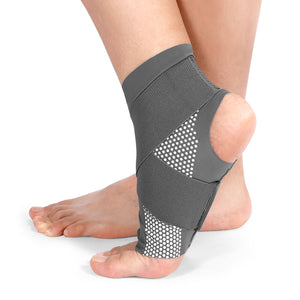How to Wear an Ankle Brace?

An ankle brace is an essential instrument for giving support and stability to the ankle joint. If you suffer from an ankle sprain or chronic ankle instability or are engaging in sports activities, wearing an ankle brace would be of great importance to you.
In this article, you will learn how to wear an ankle brace correctly, when ankle support helps, and the pros and cons of wearing ankle support after a sprain. Moreover, it will address your doubts about how many hours you should wear an ankle brace and suggest the best quality ankle braces.

What’s Ankle Brace?
Before we move to the part of how to wear an ankle brace, let’s first figure out what the ankle brace is. The ankle brace is an instrument developed to safeguard and help the ankle joint. It is usually composed of fabric, straps, and, sometimes, rigid materials. Its primary function is to manage ankle overpronation and provide stability, which is good for injury prevention and healing.
The ankle braces are found in different kinds, which include varied designs and levels of support. For instance, there are compression braces, lace-up braces, and rigid braces. Choosing the right type of ankle brace is essential and depends on your needs and the severity of your injury.
When Do You Need Ankle Braces?
Ankle braces are helpful in many scenarios, especially when the ankle joint requires additional support and stabilization. The following are some of the situations in which ankle braces play a critical role:
-
Recovery from Ankle Sprains or Surgery
An ankle sprain is a prevalent ankle injury that happens when the ligaments supporting the ankle overstretch or tear. The use of an ankle brace during recovery keeps the damaged ligaments in place, reducing further occurrence of overstretching to facilitate proper healing.
In this case, ankle braces help to alleviate the pains and swellings associated with sprain. Moreover, after undergoing ankle surgery, a brace is recommended to provide protection to the wounded area and stabilize the joint to support healing.
-
Chronic Ankle Instability
Chronic ankle instability is a situation where an individual experiences recurrent ankle sprains, or sometimes the ankle is said to be giving away. When an individual wears an ankle brace, the brace helps hold the joint together, reducing the likelihood of instability and further sprain, and gives one a supportive feeling.
-
Athletic Activities
Athletes who engage in high-impact sporting activities or events involving excess stress to the ankle will benefit from the use of ankle braces. It provides additional support, decreasing the chances of sustaining ankle injuries while jumping, pivoting, or moving suddenly in different directions.
-
Injury Prevention
Finally, an ankle brace can help avoid potential harm. It restricts abnormal movement and provides ligament support, helping the ankle joint retain its shape, thereby lessening the likelihood of sprains during sports activities. It also offers stability, mitigating ankle injuries resulting from excessive inward or outward rolling.
How to Wear an Ankle Brace?
If you already have an ankle brace in your hand, the next step you may wonder about is how to put on an ankle brace, like the question of an ankle brace under or over socks. Here is the step-by-step procedure of how to wear an ankle brace:
Position and Steps
- While sitting, place the brace on the target foot;
- Position the heel so that it is at the posterior of the brace;
- Begin wrapping the brace around the bottom level and progressively get to the top;
- Ensure that the straps are as tight as possible;
- Pay attention to the straps’ tension – they should be sufficiently tight to support the foot without being excessively tensed.
Assessment and Adjustment
- Stand after placing the ankle brace to ensure it fits;
- The brace should provide support and stabilization without causing any discomfort or restricting the movement;
- Make the adjustments to the straps if necessary. Importantly, each person has a unique form and size of the ankle; therefore, it is imperative that you select the one that perfectly fits the ankle.
Regarding the sock question, the key is to check for the manufacturer’s instructions for the ankle brace. Some braces are designed to be worn over the sock, while others are meant to be worn directly against the skin. If there are no instructions, you may try both to see which feels better for you.
In terms of how to wear shoes with an ankle brace, you shall go for shoes that are wide and deep enough to accommodate the extra volume of the ankle brace you wear. Lace-up shoes or adjustable straps could be your perfect choice. The next steps you should focus on are fit, comfort, and support.
Should I Wear an Ankle Brace After a Sprain? Pros and Cons
Learning how to wear an ankle brace is far from enough. To maximize this ankle support’s effects, you should also master its benefits and potential disadvantages. Next, let’s explore the pros and cons of an ankle brace by using the case of wearing an ankle brace after a sprain.
Pros:
By providing external support to the injured ankle, the ankle brace contributes to stabilizing the joint and reducing excessive movement. It prevents further injury, particularly during activities that involve rapid changes in direction or jumping.
Furthermore, the additional support reduces strain on the injured tissues, which promotes faster recovery. Your pain can also be alleviated due to the appropriate level of compression. Besides, it serves as a defensive shield covering the ankle from external blows and additional injuries.
Cons:
The extended use of the ankle brace will eventually result in muscle weakness because the brace supports what the muscles typically support. This can be controlled by regular exercises and physiotherapy. An ankle brace may also limit mobility, but this is a necessary restraint for the purpose of avoiding any reinjury. A few patients may suffer from skin irritations from prolonged wearing or poor brace ventilation.
Best Strategies:
To make the most of wearing an ankle brace after a sprain, consider the following strategies:
- Right Fit and Type: Make sure the ankle brace is well-fitted and offers the required support for your type of injury. Consult your healthcare professional to help you identify the best type of brace for you.
- Gradual Introduction: At the beginning of your recovery, it is okay if you wear the ankle brace for most of the day to get enhanced support and faster healing. But as your pain gets eased and your ankle starts to gather strength, you may gradually reduce the frequency of brace wear during daily activities.
- Physical Therapy: When using an ankle brace, don’t forget to incorporate physical therapy exercises to strengthen the ankle muscles and improve joint motion range. Consult a healthcare professional for a structured rehabilitation program that will help your full recovery.
Should I Wear an Ankle Brace All Day?
In case you are unsure about how long you should put an ankle support, this section will highlight the factors that require consideration.
-
Severity of the Injury
In mild ankle sprains or strains, an ankle brace can be worn during activities that stress the ankle for a few hours per day. However, for severe sprains or fractures, it would be necessary to wear the brace for extended periods.
Usually, it is recommended to take off the ankle support at night to facilitate ventilation for the ankle joint and skin. Yet, there are scenarios in which all-day wear is needed. You may consult your doctor for individualized recommendations.
-
Rehabilitation Stage
In the early rehabilitation phase, when the injury is fresh, consistently wearing the brace may be crucial for optimal healing. With the improvement of ankle stability and muscle strength, you may gradually reduce the duration of brace wear under the guidance of a healthcare professional.
-
Activity Level
If you engage in activities that place stress on the ankle joint, such as sports or physically demanding work, you may need to wear the brace for longer periods. Conversely, if you live a sedentary lifestyle or just handle desk-bound work, you may only need to wear the brace during specific activities or rehabilitation exercises.
-
Comfort
If wearing the brace causes significant discomfort or restricts mobility to an uncomfortable extent, it may be advisable to remove it periodically throughout the day. Try re-evaluating the device or considering another option. Balancing between support and comfort is key to the effective use of an ankle brace.
FIVALI’s Ankle Braces
When it comes to ankle braces, FIVALI offers top-quality options that provide excellent support and comfort. Here are two recommended ankle braces from FIVALI:
This ankle brace features an innovative design with inflatable airbags that provide customizable compression and support. It is a flexible fit for the various sizes of the ankle and is suited for feet measured from 5-12 US shoe sizes. With features like breathable lining air bag pads, dual Velcro straps, and adjustable heel bands, this inflatable ankle splint is an excellent choice to reduce ankle pressure and pain.

Benefits:
- Flexible Foot Movement Support: Enables smooth movement.
- Compression: Aids in swelling and inflammation control.
- Customizable Fit: Provides customized optimal support.
- Versatile Use: Appropriate for both injury recovery and preventive care.
The Fivali Ankle Support is a flexible ankle brace that provides a mixture of support and movement. Made from skin-friendly and elastic fabric, it is comfortable for long-term wear. Users of this ankle support include athletes and people in need of extra stability during physical activities. It permits normal foot movement while minimizing slippage during activities.

Benefits:
- Ankle Sprain Prevention: Aids in decreasing the chance of ankle injuries during participation in sports.
- Comfortable Wear: Perfect for prolonged wearing during sports or daily activities.
- Durable Construction: Guaranteed longevity of support and performance.
We have figured out how to wear an ankle brace in this article. Moreover, we explore more questions beyond how to put ankle support, like when you need an ankle brace and whether you need to wear the ankle support all day. It is clear that an ankle brace is beneficial for both preventive and functional purposes.
Evaluate the pros and cons, consider the duration of wear based on your specific circumstances, and choose a high-quality ankle brace to ensure optimal results. FIVALI, a trusted sports brace brand, can be your perfect destination to explore professional ankle support.













